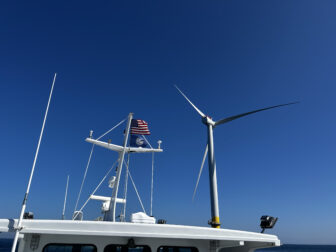By Cynthia Houston. Originally published in SpinSheet December 2017.
The flotilla of dozens of activists in kayaks who paddled down the Potomac River in August carrying protest banners that called for Maryland Governor Larry Hogan to reject the Eastern Panhandle Expansion Project is not a commonplace occurrence in the Potomac River watershed. Dubbed “kayaktivists,” this relatively new approach to activism has spread from Seattle and Portland to the East Coast and the banks of the Potomac.
The kayaktivists were a part of an extensive anti-pipeline campaign that included “rolling encampments” on the Potomac and C&O Canal over the summer in addition to hundreds of Maryland and West Virginia residents joining hands to form a chain across the Potomac’s James Rumsey Bridge in October. Environmental advocates that include the Chesapeake Climate Action Network, the Eastern Panhandle Protectors, and the Potomac Riverkeepers have joined forces with landowners and citizens to influence what they see as a decision that ultimately lies with Governor Hogan.
The protests were against the proposed development of a 3.5-mile underground natural gas pipeline that would run across the narrowest part of Western Maryland, transporting fracked gas from Pennsylvania to West Virginia. The pipeline would provide 47,500 dekatherms of natural gas per day to West Virginia. Protestors and environmental activists are most concerned about a section of the pipeline that would cross under the Potomac River and the Chesapeake and Ohio Canal (C&O) – a risk they feel it too great to manage. Protestors also believe that the transport of fracked gas goes against the statewide fracking ban that Hogan signed in April.
In March, an application was filed by Calgary, Alberta-based TransCanada to the Federal Energy Regulatory Commission (FERC) to gain approval to install the pipeline in Maryland, which according TransCanada’s video on the project is slated to be buried 72 feet underground when it crosses under the Potomac. FERC, the National Parks Service, and Maryland’s Department of the Environment (MDE) must approve the pipeline, and TransCanada must obtain more than 40 required permits. But anti-pipeline protestors have identified that the tipping point of this lengthy environmental assessment process lies with Governor Hogan. If the MDE grants TransCanada a 401 Water Quality Certificate under the Clean Water Act, certifying that the pipeline project would not negatively impact water quality in the state, Hogan can reject the certificate.
Maryland’s decision is a difficult one, and there are many voices in the mix. But if you think of the “who, what, where, when, why, and how” of the pipeline’s installation, there are several factors to consider that demonstrate risks that counter the benefits gleaned by West Virginia’s economy.
Who
TransCanada operates a 56,900 mile network of natural gas pipelines in North America, supplying more than 25 per cent of the natural gas consumed daily across the nation. President George W. Bush approved TransCanada’s first pipeline into the United States, “Keystone I,” in 2007. Scott Castleman, a TransCanada spokesperson, stated that the proposed Maryland pipeline would be buried up to 100 feet beneath the riverbed, with walls twice as thick as required, and would be constantly monitored for leaks and surges. Castleman stated that TransCanada has more than a century of experience building pipelines in the area. “A dozen TransCanada pipelines already cross under the Potomac River in Maryland,” Castleman stated.
However, as recently as March, the Department of Transportation’s Pipeline and Hazardous Materials Safety Administration submitted to TransCanada’s ANR Pipeline Company a Notice of Probable Violation Proposed Civil Penalty and Proposed Compliance Order, which identified that the company “did not use properly and well qualified welding procedures” at the ANR Lincoln Storage Field Line in Michigan, and did not properly monitor corrosion at pipe supports and at soil-to-air interface locations at the Michigan Bridgman Compressor station. In January, 2014, a TransCanada pipeline in Canada about 50 miles north of the North Dakota border ruptured and exploded. The local fire chief, Jeff French, described 20-30 foot high flames that were 10-15 feet wide shooting out of the ground. “You could see it from miles away,” French said. It took 12 hours to get the fire under control.
What
As a sign of good faith, TransCanada has agreed to bury the pipeline at approximately 100 feet in the area under the Potomac riverbed. Will Carey, an energy consultant with decades of gas industry experience, has shared that “the commitment to bury the pipeline deeper below the riverbed makes sense, and is a sign that TransCanada is compromising with the community on solutions.” Maryland Senator Richard Madaleno (D) has a different perspective. “Pipelines fail, pipelines leak. We’re putting it where it is potentially most dangerous, where pipelines have failed in other states. Why do that and risk all of the drinking water for the national capital region…? It’s just not a smart thing to do.” Carl Weimer, Executive Director of the Pipeline Safety Trust, has stated that, “new pipelines are failing even worse than the oldest pipelines.” According to Weimer, the rush to expand natural gas pipelines has resulted in fewer quality controls, and new transmission lines are failing at the same rate as those constructed in the 1940s. Brooke Harper, Maryland Policy Director with the Chesapeake Climate Action Network and Environmental Chair for the Maryland State Conference NAACP, has stated, “This pipeline would bring no benefits whatsoever to the state of Marylanders, only risks.”
Why
According to John Reisenweber, executive director of the Jefferson County Development Authority in West Virginia, the region’s existing pipeline system is limited and “basically out of capacity.” West Virginia’s Secretary of Commerce, H. Wood Thrasher, has stated, “The TransCanada pipeline is fundamental for the economic future of the eastern panhandle of West Virginia. Having a steady and reliable source of natural gas is vital to attracting businesses and industry to our state.” David Smith, city manager for the Town of Hancock, also supports the pipeline, saying, “we’ve done our due diligence and feel that [the] company we’re dealing with has expertise in this field.” West Virginia’s Public Service Commission has granted permission to the Mountaineer Gas Company, that area’s largest natural gas provider, to begin construction of a pipeline between Berkeley Springs and Martinsburg, West Virginia, that will receive the gas from the Maryland connection. West Virginia has already been to court with some landowners, and the use of imminent domain to obtain access to the land required to install pipeline has been granted.
Where
In a nutshell, Governor Hogan is between a rock and a hard place – and that rock is in large part the karst topography bedrock of Western Maryland. Karst terrain is limestone (calcium carbonate); erosion, fissures, and sinkholes are common features of karst terrain. In karst topography, rainwater infiltrates horizontal and vertical cracks, dissolving the limestone, and creating vertical fissures that widen and deepen over time. Permeating water continues the development of the underground cracks – underground stream channels form, vertical shafts may open, and cave systems may emerge. Upper Potomac Riverkeeper Brent Walls has stated that, “karst geology is very sensitive geology that poses greater risks than normal construction practices for pipelines.” In his position as Riverkeeper, Wells has stated that, “it doesn’t matter how far below the river the natural gas line is constructed, because if it ruptures the gas will seep through crevices in the soil and it would be nearly impossible to track where it goes.” The threat? The Potomac River serves as the primary source of drinking water for more than 6 million residents downstream.
Another concern voiced by many is the potential impact on Western Maryland’s economy if a rupture or leak were to occur. “Tourism is the economic driver in the [area],” said Cannon. “We cannot afford to damage our pristine environment.” Drilling would occur under a portion of the Potomac River listed as sensitive on the Nationwide Rivers Inventory, and the pipeline could potentially impact the C&O Canal, a National Historic Register site visited by millions of people every year.
How
Horizontal Directional Drilling (HDD) would be used to construct the section of the pipeline under the Potomac. HDD is used to install pipelines under bodies of water, roads, railways, buildings, and other structures. According to TransCanada, HDD is an “environmentally friendly approach method used to cross sensitive areas.” In HDD, temporary wetland mats are laid down on top of construction bore areas. The pipeline is then installed using a three-phase process. First, a pilot hole is created by excavation via a downhole motor. In the second “pre-reaming” phase, the diameter of the underground path is increased to 12 inches with a “hole opener” that takes into account soil condition and density. In the third and final stage, “pullback,” the gas pipeline is fed into the reamed hole. According to TransCanada, a well-cap and swivel is placed which prevent any rotation of the pipeline. At the completion of HDD, TransCanada ensures restoration of the operating area. Tracy Cannon, an organizer with Eastern Panhandle Protectors, has stated that using HDD in karst topography would create pathways for water to drain down bore holes and dissolve the limestone around the piping. This could create sinkholes, resulting in subterranean ruptures. As recently as October, FERC had to clear Rover Pipeline to resume work at four HDD locations in Ohio after a 2 million gallon drilling fluid spill. FERC allowed Rover to resume only after third-party independent inspectors were established to oversee the HDDs and “further safeguard sensitive environmental features” to include the area’s karst topography. According to Cannon, even if there is no catastrophic accident while drilling into karst, the bedrock will be destabilized.
When
At present, as part of the permitting approval process FERC is requesting feedback that focuses on “the potential environmental effects, reasonable alternatives, and measures to avoid or lessen environmental impacts” – this input will be used to determine what issues need to be evaluated in the Environmental Assessment. Over the past year, Wells said he and his fellow advocates’ actions have slowed the timeline for the project. “We are pretty happy about that…they are actually considering alternate routes because they realize that the route that they have chosen could be in danger of being stopped,” he said. In terms of the MDE’s potential granting of the 401 Certificate, Maryland Environment Secretary Ben Grumbles has stated that, “we have requested additional information from the applicant on environmental impacts and engineering features,” and that “we are committed to protecting our precious Potomac River and the communities and resources that depend on it.”
Resources
TransCanada video demonstrating the HDD process is available at this link.





